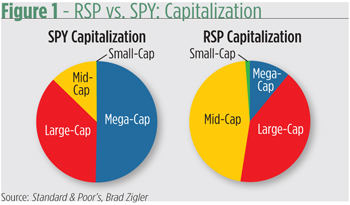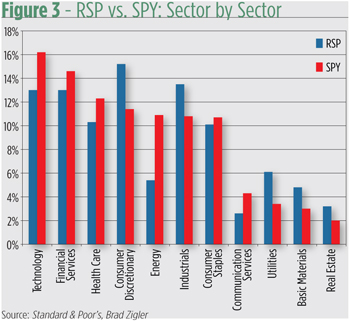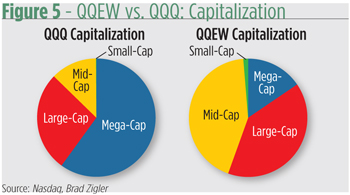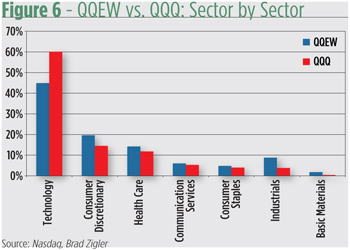Let’s get one thing straight at the outset: equal weight does not necessarily mean equal results. Consider this: In April, a couple of equal-weighted equity portfolios celebrated their birthdays. The Guggenheim S&P 500 Equal Weight ETF (NYSE Arca: RSP) was celebrating its tenth anniversary with market-busting returns. The First Trust Nasdaq-100 Equal Weighted ETF (NasdaqGM: QQEW) had less reason to party; in the seven years since inception its results have lagged the contemporaneous returns of the capitalization-weighted version of the index (NDX).
Of course, the performance of cap-weighted indexes hew more closely to their large stock constituents while the returns of medium- and small-sized issues are more vividly depicted in equal-weighted funds, so it’s easy to say that RSP’s outperformance (and QQEW’s underperformance) can be attributed simply to size alone, but is that really so?
 RSP vs. SPY
RSP vs. SPY
There’s no doubt that RSP’s capitalization pie is baked with different proportions of benchmark components than the traditionally cap-weighted structured of the S&P 500 SPDR (NYSE Arca:SPY). There’s an especially wide disparity at the top of their capitalization tiers. Half of SPY’s total capitalization is made up of mega-cap stocks (companies with market values in excess of $200 billion) while the giants take only 11 percent of RSP’s line-up. Surprisingly, there’s not much difference between the two fund’s large-cap allocations. (See Figure 1.)
With nearly half of RSP’s value coming from middle-tier stocks, investors may be inclined to think RSP mirrors the performance of a mid-cap index such as the S&P MidCap 400. To a certain extent, that’s true. Over the past decade, the r-squared coefficient (r2) of RSP to the SPDR S&P MidCap 400 ETF (NYSE Arca: MDY) is 0.92, an impressively tight correlation. Still, RSP’s 16.5 percent average annual return lags the 18.3 percent earned by MDY, giving RSP a lower Sharpe ratio and alpha (α) coefficient. There’s no overlap in the names comprising RSP and MDY portfolios, either.
The biggest difference between RSP and SPY isn’t the names of the stocks they hold, but the proportion. Because a cap-weighted index allocates space on the basis of market capitalization, overvalued companies are weighted more heavily while undervalued stocks have less heft. By contrast, an equal-weighted index reserves the same amount of real estate for each issue, regardless of market value.
Nothing better illustrates the incongruent exposure to risk than the recent price gyrations in Apple Inc. (Nasdaq: AAPL). At month’s end in March, with AAPL shares trading for more than $440 per copy, SPY risked nearly four percent of its capitalization on the Silicon Valley company. The equal-weighted RSP portfolio gave over just 0.22 percent (approximately 100 percent of the portfolio weight divided over 500 stocks) of its capitalization to AAPL.
Now, think back to 2012. Remember AAPL at $700? For the first nine months of 2012, as AAPL rallied $300 a share, SPY gained 16.4 percent. RSP lagged behind with a 14 percent rise. But as AAPL subsequently slumped $135 in the fourth quarter, RSP eked out a 2.7 percent gain against SPY’s 0.4 percent loss.
The lesson investors should take away is this: As long as big stocks stay on a steeper upward trajectory than medium-sized issues, the cap-weighted product’s inherent overweighting pays off in higher returns. Quite the opposite results should be expected when big companies stumble and mid-caps become the market leaders. Then, RSP should outdo SPY.
While there have been discrete time periods when RSP underperformed SPY, the equal-weighted portfolio’s cumulative return has exceeded the cap-weighted fund’s over the long run. Figure 2 tells the tale of the tape over RSP’s lifespan.

Cap-weighted indexes are often said to lean toward a growth style. This makes sense since weighting and stock price are directly related and price momentum is a growth characteristic. Equal-weighted benchmarks tend to exhibit a value tilt. Indeed, there are notable distinctions between RSP and SPY across some value factors. RSP’s price-to-book ratio, for example, is currently clocked at 2.05 while SPY lays down a 2.21 chalk mark.
But there’s another metric that better gauges the difference between equal- and cap-weighted indexes: sector breakdown. As stocks’ market values ebb and flow, the size of a cap-weighted index’s sector exposure can vary considerably more than that of one equally weighted. The degree by which a market-cap benchmark is “overexposed” in an index may in fact foretell cyclical changes in the economy.
A typical pattern begins after a market bottom when technology and industrial stocks turn higher. Gains in basic materials companies follow to signal the midpoint of the growth period. The late stages of an expansion are then marked when energy, health care and consumer staples stocks are ascendant. As the market subsequently weakens, utilities and communication issues take the lead. Finally, the outperformance of consumer cyclicals, financials and real estate stocks herald the late stages of a recession.
 As shown in Figure 3, SPY’s largest exposures are presently technology (16 percent of capitalization) and financial services (15 percent), reflecting the unevenness in the nascent U.S. recovery. In contrast, RSP gives up 13 percent to the technology and financial services sectors.
As shown in Figure 3, SPY’s largest exposures are presently technology (16 percent of capitalization) and financial services (15 percent), reflecting the unevenness in the nascent U.S. recovery. In contrast, RSP gives up 13 percent to the technology and financial services sectors.
RSP’s relative underweight in technology is more than made up by a heftier allocation to the consumer discretionary sector (15 percent). SPY’s capitalization includes just an 11 percent dollop of these stocks. RSP also has heavier exposure to utilities (by nearly three percent) compared to SPY.
There’s something more telling, though, in the smaller allotments. Collectively, SPY has the greatest overweight compared to RSP in consumer staples, health care and energy stocks. Does that telegraph an imminent recession? Time will tell.
QQEW vs. QQQ
Will buying an equal-weighted fund always deliver superior returns to those that are cap-weighted? Not always. Equal weighting the Nasdaq-100 (NDX) index hasn’t paid the same kind of dividends as those earned by the S&P 500 product. Keep in mind that the Nasdaq-100 tracks a century of the largest non-financial stocks traded on the Nasdaq Stock Market. Compared to the S&P 500 (SPX), NDX represents a much narrower investment universe. Not only is NDX devoid of financial stocks, there are no real estate, energy or utility components. As a result there’s much more concentration in NDX than SPX.
Take a look at Figure 4. You’ll see the cap-weighted PowerShares QQQ Trust (Nasdaq: QQQ) has outperformed the equal-weighted First Trust Nasdaq-100 Equal Weighted ETF (NasdaqGM: QQEW)on a number of metrics since the latter’s 2006 launch.

So why didn’t equal weighting pay off with the NDX-based product as it did with that tracking SPX?
The key word, of course, is capitalization. QQQ is much more a mega-cap product than QQEW. More so, in fact, than SPY compared to RSP. Presently, 60 percent of QQQ’s worth can be attributed to mega-cap stocks. Market giants make up only 16 percent of QQEW’s capitalization (see Figure 5).

The differences in sector concentration dovetails with the capitalization spread. Currently, QQQ enjoys a significant overweight in technology stocks compared to QQEW. Among these issues are, of course, tech biggies such as Apple, Microsoft Corp. (Nasdaq: MSFT) and Google, Inc. (Nasdaq: GOOG). Fully 60 percent of QQQ’s current market cap is made up of tech stocks while QQEW devotes 45 percent of its real estate to these issues. That said, a decline in tech prospects will likely impact QQQ more than QQEW.
 If you relied upon the overweighting of tech issues in the cap-weighted product as an economic indicator, you might very well be inclined toward a sunnier outlook. You have to keep in mind, however, that NDX lacks most of the defensive sectors subsumed in SPX, which lessens the former’s predictive value.
If you relied upon the overweighting of tech issues in the cap-weighted product as an economic indicator, you might very well be inclined toward a sunnier outlook. You have to keep in mind, however, that NDX lacks most of the defensive sectors subsumed in SPX, which lessens the former’s predictive value.
Another Way
From what we’ve seen, equal weighting can be either an investor’s boon or bane. The decision to use an equal-weighted product over a more traditional cap-weighted fund is largely predicated upon risk perception. Each weighting method exposes investors to a unique set of dangers, as well as the possibility of outperforming the markets.






